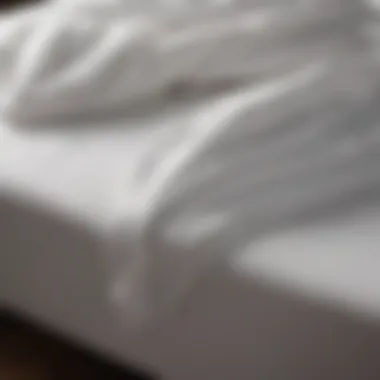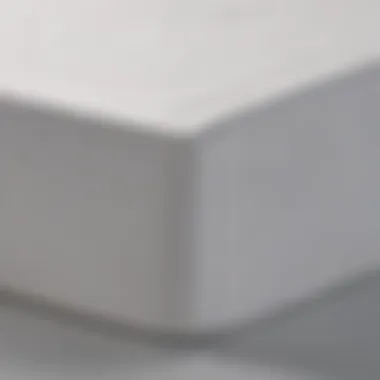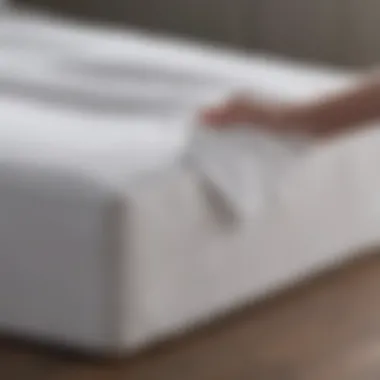Master the Art of Folding a Fitted Sheet


Intro
Folding a fitted sheet is a task that many find perplexing. Unlike regular flat sheets, the elasticated corners of fitted sheets create a unique challenge. As a result, many people store them in a crumpled state, leading to an unorganized linen closet. This article delves into the intricacies of folding a fitted sheet with precision. You will discover not only the step-by-step process but also tips that elevate your sheet folding technique. This guide serves both beginners, who are just embarking on this task, and those who seek to refine their method.
By mastering this skill, you will significantly enhance the presentation of your linens, making your home appear more polished and organized. The joy of achieving a tidy finish cannot be overstated; it reflects attention to detail and a sense of order in your living space. Maintaining the shape and integrity of your fitted sheets also prolongs their life, adding to the value of learning this essential task.
Understanding the Fitted Sheet
Folding a fitted sheet is a challenge for many, making the understanding of its structure essential. Knowing the features of a fitted sheet helps simplify the folding process. Each element influences both functionality and aesthetics in bedding presentation.
Definition and Purpose
A fitted sheet is a type of bed linen designed to fit snugly over a mattress. It has elastic edges, allowing it to hug the mattress closely, preventing it from slipping off during use. The primary purpose is to provide comfort, protection, and a clean, attractive layer over the mattress. Furthermore, properly folded fitted sheets contribute to a well-organized linen closet, making it easier to find and access when needed.
Material and Construction
Fitted sheets are made from various materials such as cotton, polyester, linen, and blends. The choice of material affects comfort, breathability, and durability. For instance, cotton sheets are soft and breathable, while polyester sheets are more resistant to wrinkling and fading.
Different weaving techniques also play a role in the quality of fitted sheets. Percale and sateen are popular weaves that alter the sheet's feel and appearance. Understanding these materials and constructions can guide consumers in selecting the perfect fitted sheet for their needs.
Common Sizes
Fitted sheets come in several standard sizes to accommodate various mattress dimensions. The most common are Twin, Full, Queen, and King sizes. Each size is designed to fit specific mattress dimensions, ensuring a proper fit.
- Twin Size: Generally 39 x 75 inches
- Full Size: Typically 54 x 75 inches
- Queen Size: Measures around 60 x 80 inches
- King Size: Roughly 76 x 80 inches
Understanding these sizes aids in selecting the right sheet, which is crucial for both comfort and aesthetics. When fitted sheets are correctly matched to the mattress size, they enhance the overall bedroom look while ensuring a restful sleep.
Preparing to Fold
Folding a fitted sheet may appear to be a simple task, but a successful outcome often hinges on adequate preparation. Attention to detail in this phase enhances both the efficiency and effectiveness of the final folding process. Proper preparatory steps can lead to a more organized linen closet and a sense of accomplishment. This section outlines what needs to be considered before you begin folding your fitted sheets.
Gathering Necessary Tools
Before you fold your fitted sheets, it’s important to have certain tools and materials at hand. You do not need many things, but having the right ones can simplify the process significantly.
- Flat Surface: A clean, flat surface where you can spread out the fitted sheet works best. This can be a bed, a table, or even the floor. The key is ensuring that you have enough space to work without feeling cramped.
- Time: Allocate a small block of time for this task. Rushing through it can lead to inaccuracies and a poor result.
- Optional Items: If you prefer, you can have other tools like a measuring tape or ruler to create precise folds, but these are usually unnecessary for the typical folding method.
- Linen Basket: Keep a basket or container close by for storing folded sheets. This keeps them organized and ready for future use.
The presence of these items can alleviate frustration and provide a smoother experience when folding.
Choosing an Appropriate Surface
The surface on which you decide to fold your fitted sheet can greatly impact the overall outcome. Choosing wisely can make the task easier and more efficient. Here are some considerations for selecting the right surface:
- Size Matters: Ensure that the surface is large enough to accommodate the sheet fully extended. This is especially important for larger sizes like queen and king.
- Clean and Dry: The area should be clean and free from clutter. Dust or moisture can affect the cleanliness of your linen. In addition, avoid folding on surfaces where food is prepared.
- Height Considerations: Opt for a surface at a comfortable height. If you are folding at a table or counter, it should not strain your back or arms. Being at the correct height makes the entire process more ergonomic.
- Good Lighting: Ensure that the area is well-lit. Adequate lighting not only makes it easier to see the sheet but also helps you spot any wrinkles or areas that need correction before you complete the fold.
Overall, the right surface selection sets the stage for a successful folding operation and can help in maintaining the quality of your fitted sheets.


Step-by-Step Folding Process
The step-by-step folding process is an essential aspect of mastering the art of folding a fitted sheet. This structured approach allows you to manage the complexities involved with fitted sheets, transforming a daunting task into a straightforward endeavor. Each step builds on the previous one, ensuring a neat and organized result. Following a systematic method not only enhances efficiency but also strengthens the likelihood of achieving a tidy finish. Thus, this process becomes particularly beneficial for homeowners and anyone who values organized linen storage.
Identifying the Corners
Identifying the corners of a fitted sheet is the starting point of the folding process. Fitted sheets have elasticized corners designed to hug the mattress. To do this correctly, hold the sheet with the inside facing towards you. Locate the two corners on one side. You should use your fingers to feel the fabric where the elastic is sewn. This will help you get a sense of the sheet's structure. Once you identify the corners, it becomes easier to manage the fabric in subsequent steps.
Tucking the Corners
Tucking the corners is the next step. This action involves carefully folding each corner into the center of the sheet. Begin with one corner, allowing the fabric to fold inward while simultaneously moving the other corners toward the center. Hold the first corner in your hand while reaching for the opposite corner. This technique will create a pouch-like shape. Tightening the corners at this stage is essential, as it will ensure a compact fold.
Folding the Sides
After securing the corners, you can proceed to fold the sides of the sheet. Lay the sheet flat on your chosen surface. Gently fold one side over the center, then repeat for the other side. This creates a more symmetric shape. Make adjustments to ensure the fabric lies flat with minimal wrinkles. The precision of this step will greatly influence the overall appearance of your folded sheet.
Creating a Rectangle
The final step of the folding process is to shape the fitted sheet into a rectangle. Begin from any one end of your already folded sheet and roll or fold carefully toward the other end. Make sure to smooth out any excess fabric that may create bumps. This transformation into a rectangle is significant, as it not only enhances storage but also provides an aesthetically pleasing appearance when placed in closets or storage bins. By achieving a flat, rectangular shape, you facilitate easier organization of your linens.
"A neat fold enhances both the presentation and accessibility of your linen storage."
Adopting this step-by-step folding approach elevates the experience of handling fitted sheets. It is a strategy that yields both visual and practical benefits, catering to those seeking to refine their organizational skills in the realm of home management.
Techniques for Various Sizes
When it comes to folding fitted sheets, understanding the different techniques suitable for various sizes is essential. Each bed size presents its own unique challenges and advantages. Therefore, knowing how to adjust your approach based on the sheet's dimensions enhances efficiency and ensures a neat final product. Having this knowledge not only contributes to better organization but also prolongs the lifespan of your linens.
Twin and Full Size
Folding twin and full size fitted sheets is relatively straightforward due to their smaller dimensions. To begin with, these sheets typically have less elastic material, making it easier to manipulate them into a tidy shape. First, follow the established steps for tucking in the corners and flattening the edges.
- Hold the sheet with the elastic side facing towards you.
- Identify the two bottom corners and tuck them into the top corners effectively.
- Lay the sheet down on a flat surface, smoothing out any wrinkles.
For storage, you can fold these sheets into a compact rectangle, making them easy to stack in a closet or drawer. Consider organizing twin and full size sheets separately to avoid confusion when making the bed.
Queen Size
Queen size fitted sheets present slightly more complexity due to their larger structure. The added dimensions require careful handling to ensure a seamless fold.
- As with other sizes, start laying the sheet with the elastic sides up.
- Tuck the corners into one another, ensuring they are secure.
- Smooth out the fabric to eliminate creases; this usually requires more effort to achieve a neat finish.
When folded, queen size sheets can be a little bulkier, so stacking them properly is critical. You may want to place them vertically on shelves to utilize space effectively.
King Size
King size fitted sheets can be daunting for many due to their substantial size and elasticity. To fold them successfully, patience and a clear workspace are paramount.
- Begin by laying the fitted sheet flat on a clean surface with the elastic side facing up.
- Bring the corners together as you would with smaller sizes, but ensure a secure fit as the larger dimensions can cause slippage.
- Utilize your body weight to help keep the sheet in place while you smooth and fold.


Finally, once folded, king size sheets can take up more space. Consider using storage containers to manage these larger items efficiently. Organize them by type or style to facilitate ease of access.
Mastering the folding technique of fitted sheets tailored to their size not only optimizes storage but also elevates the presentation of your linen closet.
Common Mistakes to Avoid
Folding a fitted sheet is an acquired skill, and many often find themselves grappling with its intricacies. However, understanding common mistakes can significantly ease the learning process. Avoiding these pitfalls is essential as it ensures a neater outcome and extends the life of your linens. Several errors tend to arise during the folding process and in subsequent storage. Being aware of these can lead to better practices and improved linen management.
Overlooking the Elastic Edges
One prevalent mistake is neglecting the elastic edges of the fitted sheet. Many individuals focus on the flat parts, neglecting the corners where the elastic is stitched in. This oversight can lead to an uneven fold and wrinkles when the sheet is placed back onto the bed. The elastic holds the sheet tightly to the mattress, so proper attention to these edges during folding can facilitate a smoother shape and presentation.
To address this mistake, follow these tips:
- Take a moment to examine the elastic edges before you start folding.
- Handle the corners with deliberate care to integrate them smoothly into the fold.
- Consider tucking the elastic edges into the center during the folding process. This will help manage the elastic and keep it from sticking out awkwardly.
Improper Storage Techniques
Improper storage techniques present another significant hurdle in maintaining the organization of your fitted sheets. Some might simply toss the folded sheet onto a pile, which can cause creases and make it harder to retrieve later. Others may opt to shove it into drawer spaces without proper care, leading to fabric damage or snagging.
To optimize storage and minimize mistakes, consider the following strategies:
- Store fitted sheets in a designated area, away from daily clutter. Use a specific shelf or drawer.
- Use pillowcases or storage bags that fit the fitted sheet size. This method can prevent dust from settling and keep sheets neat.
- Regularly check the storage space to ensure linens are fresh and organized, rotating them as needed.
Caring for your fitted sheets is as crucial as knowing how to fold them. Avoiding these common mistakes will ensure you maintain a high standard of aesthetics and functionality in your linen storage.
Maintaining Your Fitted Sheets
Maintaining fitted sheets is a crucial aspect of home care that often goes unnoticed. The condition of your bedding affects both its longevity and the comfort it provides. By understanding the proper maintenance techniques, you not only ensure a cleaner sleep environment but also enhance your investment in quality bedding. Regular care leads to sheets that feel fresh and last longer, giving you better value.
Washing and Drying Best Practices
To preserve the life of your fitted sheets, washing and drying them correctly is essential. Here are some best practices:
- Water Temperature: Use cold or warm water for washing. Hot water can cause shrinkage and affect the elasticity of the fitted sheet.
- Detergent Choice: Opt for a gentle detergent that is free from harsh chemicals and additives. This minimizes wear and tear on fibers.
- Avoid Fabric Softener: While it smells good, fabric softener can leave a residue that may diminish the fabric’s breathability and moisture-wicking properties.
- Drying: Tumble dry on a low heat setting. High heat can damage the elastic and cause the sheet to lose its shape. If possible, air-dry your sheets, as this is the gentlest method.
Fitted sheets should be washed every one to two weeks. Factors like allergies or seasons may influence this frequency.
"Regular maintenance not only improves the lifespan of your sheets, but also contributes to a more hygienic sleeping environment."
Storage Recommendations
Proper storage of fitted sheets is just as important as maintenance practices. When fitted sheets are stored incorrectly, they can become wrinkled and lose their elasticity. Consider these recommendations for storage:
- Fold Carefully: After washing and drying, fold fitted sheets neatly. Storing them flattened prevents creasing.
- Use a Designated Space: Allocate a specific drawer or shelf for your linens. This will make it easier to access them and keep them in good condition.
- Avoid Stacking Too High: When organizing linens, try not to stack too many sheets on top of one another. This pressure can cause creasing and wear over time.
- Consider Storage Bags: For long-term storage, use breathable linen storage bags. These prevent dust accumulation while allowing airflow, which is key to maintaining fabric integrity.
By implementing these practices, you can ensure that your fitted sheets remain in excellent condition, ready for use when needed.
Benefits of Organized Linen Storage


Organizing linen storage, particularly fitted sheets, provides various advantages that extend beyond mere aesthetics. It enhances functionality, offers ease of access, and promotes proper care. Consistent practice in organizing linens not only creates a visually appealing environment, but also makes maintenance tasks simpler and more effective.
Aesthetic Appeal
The visual impact of organized linen storage cannot be overstated. When fitted sheets are neatly folded and stored, they contribute to a clean and structured appearance in linen closets or shelves. Having a dedicated space for each item allows for proper visibility. If all sheets are stacked neatly, you can easily find what you need without rummaging through piles.
An organized space can also showcase your decorative fabrics. Textured or patterned fitted sheets can enhance the overall decor of your bedroom. A well-organized storage area invites a sense of tranquility, and it reflects care for your home. Furthermore, a tidy closet can add perceived value to your living space, which may be particularly beneficial when hosting guests.
Ease of Access
Ease of access is another critical benefit of organized linen storage. When sheets are stored haphazardly, time is wasted searching for specific items during laundry days or whenever changes are needed. In contrast, a well-arranged setup allows for quick retrieval. Each fitted sheet can have designated storage, with labels if further differentiation is desired.
With sheets arranged by size or color, you can streamline your workflow. When you complete laundry, finding the right sheet becomes much easier, reducing frustration. This principle is particularly useful for homeowners who frequently entertain or have family members who might need bedding changes often.
Additionally, having an organized system minimizes the risk of damage to the linens. Sheets that are properly folded and stored are less likely to develop creases or tears, thereby prolonging their life.
"An organized linen storage doesn’t just keep your space tidy. It ensures that you're always ready for unexpected guests or changes in your home."
Alternative Folding Methods
When it comes to folding fitted sheets, most people stick to traditional methods. However, exploring alternative folding methods can lead to even better organization and efficient storage. These methods vary in execution and offer unique benefits. Understanding these alternatives is essential for any homeowner looking to streamline their linen management. Different approaches can cater to personal preferences and storage scenarios, allowing for greater flexibility.
The Roll Method
The roll method is a practical technique for those who prioritize compactness. It is particularly helpful for limited storage spaces. This approach minimizes creasing and makes it easy to access the sheets when needed. To execute this method, first, ensure that the fitted sheet is clean and dry. Then, start by laying the sheet on a flat surface, ensuring it is unfolded.
- Identify the corners: Hold the sheet by the two opposite corners.
- Tuck the corners: Fold the corners into the middle.
- Fold into thirds: Bring the edges towards the center, overlapping slightly.
- Roll tightly: Starting from one end, roll the sheet up to the other end.
- Secure the roll: If desired, use a rubber band or string to keep the roll intact.
This method not only saves space but also makes it easy to fit several rolled sheets into storage containers or on shelves.
Storage Bag Approach
Another excellent method for organizing fitted sheets is the storage bag approach. This technique provides a clear, designated space that separates each sheet neatly. It can reduce clutter and potential confusion when searching for specific linens. Using a storage bag allows sheets to remain in good shape for longer periods.
- Select the bag: Choose a transparent or labeled storage bag for visibility.
- Prepare the sheet: Fold the fitted sheet using any desired method.
- Place into the bag: Lay the folded sheet flat into the storage bag to prevent wrinkling.
- Seal securely: Close the bag tightly to keep dust and moisture away.
The storage bag approach is particularly ideal for seasonal linens or guest sheets. This method also allows for easy transportation, should you need to move linens elsewhere.
In summary, the roll method and the storage bag approach offer practical alternatives to traditional folding. Each method serves its purpose, catering to different storage needs while ensuring your fitted sheets remain organized and functional.
Culmination
Folding a fitted sheet may appear to be a simple household chore, but it holds significance beyond mere aesthetics. Mastering this skill not only enhances the look of your linen closet but also contributes to better organization of your home. By properly folding fitted sheets, you maximize space and reduce the frustration often associated with wrinkled or tangled linens. This is especially beneficial for those who frequently host gatherings or enjoy home decor.
The technique you cultivate in folding fitted sheets can also reflect on your broader approach to home management. Taking the time to fold your sheets can promote mindfulness in your daily routines, reinforcing the idea that attention to detail in small tasks can lead to a more coherent and visually pleasing environment.
Summary of Key Points
- Understanding the Fabric: Recognize the materials and construction of fitted sheets to choose the best care methods.
- Preparation is Key: Gather your tools and set up an appropriate surface for an effective folding process.
- Step-by-Step Process: Follow the structured folding steps to achieve a neat rectangle, ensuring clarity in your approach.
- Common Size Techniques: Adjust your methods based on the size of the fitted sheet you are working with for optimal results.
- Avoiding Mistakes: Be mindful of common pitfalls to ensure that your folding technique does not lead to chaotic storage.
- Maintenance Tips: Proper washing and storage techniques will prolong the life of your fitted sheets and keep them looking their best.
- Additional Methods: Explore alternative folding techniques for those who prefer different storage styles.
Encouragement for Practice
Developing proficiency in folding fitted sheets does take some practice. It may seem daunting at first, but repeated attempts will lead to an easier and more efficient process. Start with one sheet during your laundry routine. Focus on the steps outlined above and gradually refine your technique.
Remember that not every fold has to be perfect from the beginning. What matters is that you engage with the process, as this will lead to improvement. Consider setting aside time each week to practice until standardized results become second nature. The benefits of a well-organized linen closet are well worth the effort—a tidy space supports a calm mind and enhances your home experience.



